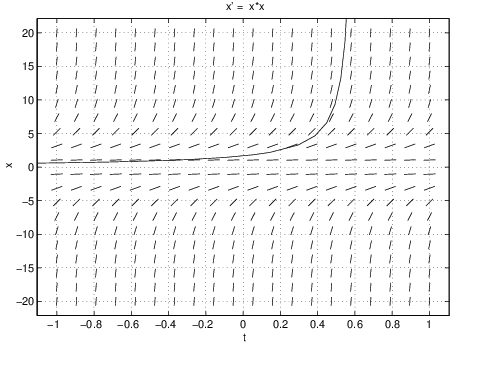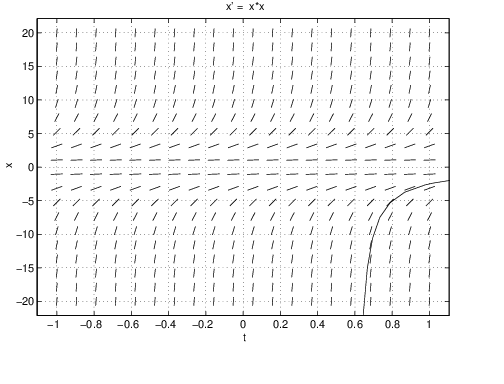In this section we discuss a method for finding closed form solutions to a particular class of nonautonomous first order ordinary differential equations
These particular equations are separable equations having the form where are continuous functions. There are two special cases of (??): the case and the case .The Special Case : Integration Theory
The assumption that in (??) leads to the differential equation
In Section ?? we saw that this differential equation is easily solved by direct integration. For example, if then the solution to (??) with initial condition is found as follows. By direct integration, It then follows that soThe Special Case : Autonomous Equations
The second special case in (??) leads to the autonomous differential equation
Begin by noting that equilibria are special solutions to (??) that we can find by solving the equation . More precisely, if , then is a constant solution to (??).We find the nonequilibrium solutions by direct integration — but only after using change of variables in integration. To solve (??), just divide both sides of this equation by , obtaining and integrate with respect to , obtaining After substituting and using the chain rule, the integral on the left becomes Replacing by , we obtain
As a simple example, solve the growth rate equation (??)
using this technique of integration. It follows that So, to solve (??), we need to know how to integrate the function . Recalling that this integral is just we obtain We solve this equation by exponentiation, obtaining where . On dropping the absolute value signs, we obtain for arbitrary . Of course, this is precisely the solution that we found in (??).It is worth reflecting on the information from calculus that we needed to solve (??). In Section ?? we found the solution to this equation by asking what function has a derivative that is a multiple of itself. We then had to remember that is such a function and then prove that up to the constant this was the only such function (recall Theorem ??). Here we needed to remember the indefinite integral of and then solve for in terms of .
We now summarize this technique for solving the autonomous differential equation (??). Let be an indefinite integral of . Then, after division by , integrating both sides of (??) with respect to leads to the equation Then we need to solve this algebraic equation for in terms of . This last step is often quite difficult, as we show by example below.
There is one additional point that needs to be remembered when using this technique. The constant is, as usual, related to an initial condition. Indeed, if we wish to solve (??) with the initial condition , then we can solve for
An Example of Blow-up in Finite Time
Consider the nonlinear differential equation
satisfying the initial condition . Using the preceding discussion, we can solve (??) by integration. Specifically, on division we obtain and on integration with respect to , we obtain Solving for in terms of we obtain Finally, use the initial condition to solve for . On substitution Hence which is fine unless happens to equal . However, in that case, we have just recovered the equilibrium solution .On setting we obtain the solution For example, if and , then and
Example (??) shows that solutions to nonlinear differential equations possess qualitative properties that are different from those of the linear equation . In particular:
- Solutions can approach infinity in finite time. For example, the solution (??) with initial condition goes to infinity as approaches .
- Solutions may not be defined for all . Indeed, the solution (??) has a singularity at and is defined for either or .
We can solve equation (??) using dfield5. Using Keyboard input set the initial condition at and obtain the trajectory in Figure ??(left). Note that this solution goes to infinity in forward time while approaching . Now set the initial condition to and see that the solution goes to negative infinity as approaches from above. See Figure ??(right). Finally note that both of these solutions are given by the same formula (??).
An Example that Cannot be Solved in Closed Form
Consider the differential equation
with initial condition . On division (??) becomes Integration with respect to yields Using the initial condition, we see that Note that for near , the initial condition implies that . Hence satisfies Unfortunately, this equation cannot be solved explicitly for as a function of ; that is, there is no closed form solution for . Nevertheless, is defined implicitly by (??). This equation can, however, be solved numerically by dfield5 just as easily as equations that have closed form solutions. See Exercise ??.The General Solution by Separation of Variables
The solution to the initial value problem for the separation of variables equation
where , is obtained by combining the integrations of the two special cases just considered.Note that if , then is an equilibrium solution to (??). So we can assume
and divide (??) by to obtain Integrating with respect to yields As before, on changing variables, we obtain Thus, the abstract solution to (??) can be written as where is an indefinite integral of and is an indefinite integral of , andAn Example Solving the Initial Value Problem
We illustrate the technique of separation of variables with the following example. Find the solution of the initial value problem where . Here and , so that Since and , we can use (??) to see that and (??) to see that the solution satisfies Therefore, The reader may check that this function is indeed a solution satisfying the specified initial condition.
An Example Finding a General Solution
With this example, we illustrate how to use separation of variables to find all solutions of a differential equation in the form (??). Consider
for . Using our notation we have Note that and hence that is the constant equilibrium solution to (??). For all the other initial conditions, we obtain Thus, in this example, identity (??) implies that the solution satisfies Hence for some constant and nonconstant solutions of (??) are in one-to-one correspondence with functions for . Note that setting recovers the constant solution .Exercises
In Exercises ?? – ?? decide whether or not the method of separation of variables can be applied to the given differential equation. If this method can be applied, then specify the functions and — but do not perform the integrations.
In Exercises ?? – ?? solve the given initial value problem by separation of variables.
In Exercises ?? – ?? use separation of variables to find all the solutions of the given differential equation.
We have studied the autonomous linear differential equation when and have shown that solutions exist for all time and tend either to or to as . See (??) and Figure ??. In Exercises ?? – ?? explore the behavior of solutions of the given nonlinear (and often nonautonomous) differential equation using dfield5. Where possible, describe the differences between the behavior of solutions of the given differential equation and the linear differential equation.
Hint: Here is a list of properties of solutions that are not valid for solutions to the linear differential equation:
- Solutions blow up in finite time (that is, ).
- Solutions do not exist for all time.
- Multiple solutions are bounded in both forward and backward time. (In the linear system only the zero solution is bounded in both forward and backward time.)
- Solutions stop (that is, solutions limit in either forward or backward time on a finite value of in finite time ).
Use dfield5 to determine which of these properties of solutions are valid for the given differential equations. Also, when exploring Exercises ?? – ?? be prepared to use the Stop button in the DFIELD5 Display window to stop the numerical integration.
- Use dfield5 to solve this differential equation numerically on the interval with initial condition . (Set the interval to be .)
- Using this result estimate the value of to two decimal places.
- Next change the time interval to be . The numerically computed solution behaves strangely when . What is the approximate value of in this range of ? Use this observed value to explain why the numerical integration for this differential equation is badly behaved.
- Use separation of variables to find the solution to the initial value problem of (??).
- Show that for the solution of (??) obtained in (a).
- For the initial condition specified in (a) compare the analytic solution of (??) to the numerical solution computed by dfield5 in the region where the maximum value of is and the maximum value of is . How does the behavior of the numerically computed solution to (??) differ from that of the analytically computed solution?
- Compute the solution of (??) using the general initial condition where and show that for every such solution.
Comment: Part (d) hints at why there is a discrepancy between the numerically approximated solution and the analytic solution: small errors in the approximate solution with initial condition near cause different solutions to be computed.

